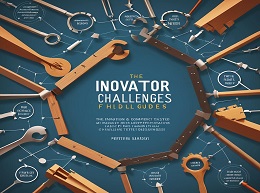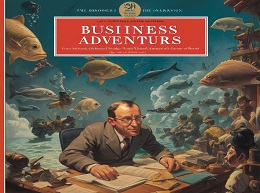The Secrets of Silicon Valley: What Everyone Else Can Learn from the Innovation Capital of the World
The Allure of Silicon Valley
Silicon Valley, the global epicenter of innovation, has long been a beacon for entrepreneurs and technologists alike. In "The Secrets of Silicon Valley: What Everyone Else Can Learn from the Innovation Capital of the World," author Deborah Perry Piscione provides an insider’s perspective on the unique ecosystem that has fostered groundbreaking advancements and world-changing companies. This review delves into the key takeaways from Piscione’s book, highlighting actionable insights and real-world examples that can inspire and guide innovators everywhere.
A Culture of Risk-Taking
One of the core themes of Piscione’s book is the culture of risk-taking that permeates Silicon Valley. Unlike other business hubs, Silicon Valley encourages experimentation and views failure as a valuable learning experience rather than a setback. This mindset has led to a high tolerance for risk, enabling rapid innovation and growth.
Example: SpaceX’s Bold Ambitions
SpaceX, founded by Elon Musk, epitomizes Silicon Valley’s risk-taking culture. Despite numerous initial failures, including rocket explosions, SpaceX persevered, ultimately achieving historic milestones such as the first privately-funded spacecraft to reach orbit and the first reusable rocket. Musk’s willingness to take bold risks has redefined the space industry and demonstrated the power of perseverance.
The Power of Proximity
Piscione emphasizes the importance of collaboration and networking within Silicon Valley. The close geographical proximity of tech companies, venture capitalists, and research institutions creates a fertile ground for the exchange of ideas and resources. This collaborative environment accelerates innovation and fosters a sense of community.
Example: Google’s Open Campus
Google’s headquarters, often referred to as the Googleplex, is designed to encourage collaboration. With open workspaces, communal areas, and a culture that values cross-departmental interaction, Google has harnessed the power of proximity to fuel innovation. Employees are encouraged to share ideas freely, leading to a continuous flow of creativity and development.
Venture Capital’s Crucial Role
Silicon Valley’s access to venture capital is a significant factor in its success. The region is home to numerous venture capital firms that provide the necessary funding for startups to scale. This financial support allows entrepreneurs to focus on innovation without the constant pressure of financial constraints.
Example: Facebook’s Funding Journey
Facebook’s growth trajectory was significantly bolstered by venture capital. Early investments from firms like Accel Partners and Greylock Partners provided the financial resources needed to expand the platform and enhance its features. This access to capital was instrumental in Facebook’s evolution from a college networking site to a global social media giant.
Diverse Perspectives Drive Innovation
Piscione highlights the role of diversity in driving innovation. Silicon Valley’s success is partly attributed to its diverse workforce, which brings a wide range of perspectives and ideas to the table. This inclusivity fosters creativity and problem-solving.
Example: Slack’s Inclusive Culture
Slack, a leading communication platform, prioritizes diversity and inclusion within its workforce. The company actively recruits talent from various backgrounds and fosters an inclusive culture. This commitment to diversity has resulted in innovative features that cater to a broad user base, enhancing Slack’s market position.
Universities as Innovation Hubs
Silicon Valley’s proximity to world-renowned universities like Stanford and UC Berkeley plays a critical role in its innovation ecosystem. These institutions not only provide a steady stream of talent but also engage in cutting-edge research that fuels technological advancements.
Example: Stanford’s Influence
Stanford University has been a pivotal force in Silicon Valley’s development. Many of its graduates, including the founders of Google and Hewlett-Packard, have gone on to establish influential tech companies. Stanford’s emphasis on entrepreneurship and its strong industry connections have created a pipeline of innovation and leadership.
The Iterative Approach
The concept of “fail fast, learn faster” is a cornerstone of Silicon Valley’s innovation strategy. Piscione explains how startups are encouraged to launch products quickly, gather user feedback, and iterate rapidly. This approach minimizes wasted resources and accelerates the development of successful products.
Example: Dropbox’s Evolution
Dropbox’s journey is a testament to the fail fast, learn faster philosophy. The company launched a minimum viable product (MVP) to test the market and quickly iterated based on user feedback. This iterative process allowed Dropbox to refine its offering, leading to widespread adoption and market success.
Long-Term Vision
Piscione discusses the importance of maintaining a long-term vision in Silicon Valley. Successful companies in the region often prioritize sustainable growth over short-term gains, investing in research and development to ensure continued innovation and relevance.
Example: Tesla’s Sustainable Mission
Tesla’s commitment to sustainability exemplifies this long-term vision. The company invests heavily in research and development to advance electric vehicle technology and renewable energy solutions. This forward-thinking approach has positioned Tesla as a leader in the automotive and energy sectors, driving both innovation and environmental impact.
Guiding the Next Generation
Mentorship is a vital component of Silicon Valley’s ecosystem. Experienced entrepreneurs and executives often mentor budding innovators, providing guidance, resources, and valuable insights. This tradition of mentorship helps sustain the cycle of innovation.
Example: Y Combinator’s Accelerator Program
Y Combinator, a renowned startup accelerator, exemplifies the importance of mentorship. Through its program, early-stage startups receive mentorship from successful entrepreneurs and industry experts. This support has helped launch numerous high-profile companies, including Airbnb and Dropbox, highlighting the impact of mentorship on startup success.
Applying Silicon Valley’s Secrets
"The Secrets of Silicon Valley" offers a compelling blueprint for fostering innovation and growth. By embracing a culture of risk-taking, leveraging the power of collaboration and networking, securing access to capital, and prioritizing diversity, education, and mentorship, organizations can replicate Silicon Valley’s success. Piscione’s insights provide valuable lessons for businesses and entrepreneurs worldwide, encouraging them to create environments where innovation thrives and extraordinary achievements are possible.
Implementing the Lessons
Readers are encouraged to implement the lessons from "The Secrets of Silicon Valley" in their own organizations. Whether it’s fostering a collaborative culture, embracing diversity, or adopting an iterative approach to product development, these strategies can drive meaningful change and sustainable growth.
Continuous Learning and Adaptation
As the business landscape continues to evolve, continuous learning and adaptation remain critical. By staying informed about emerging trends and technologies and remaining open to new ideas and approaches, organizations can navigate the future with confidence and success.













